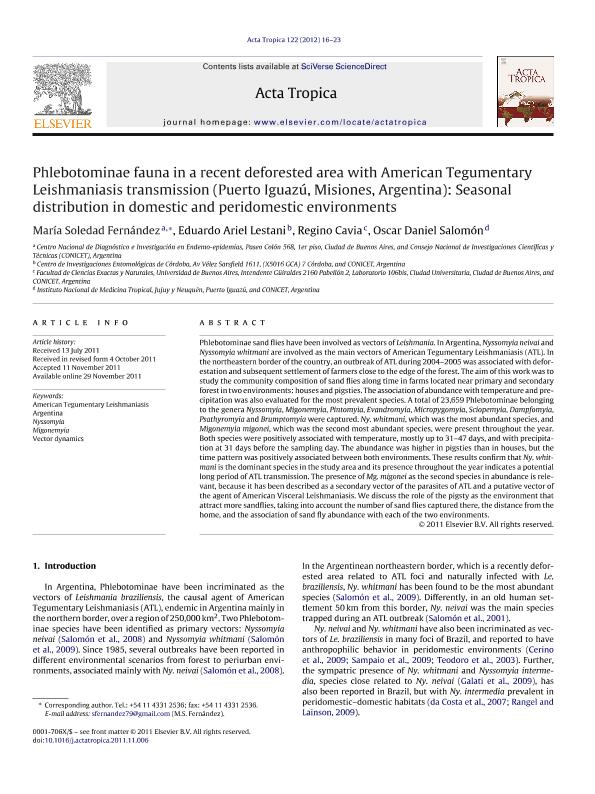Mostrar el registro sencillo del ítem
dc.contributor.author
Fernández, María Soledad

dc.contributor.author
Lestani, Eduardo Ariel

dc.contributor.author
Cavia, Regino

dc.contributor.author
Salomón, Oscar Daniel

dc.date.available
2023-05-11T13:18:02Z
dc.date.issued
2012-04
dc.identifier.citation
Fernández, María Soledad; Lestani, Eduardo Ariel; Cavia, Regino; Salomón, Oscar Daniel; Phlebotominae fauna in a recent deforested area with American Tegumentary Leishmaniasis transmission (Puerto Iguazú, Misiones, Argentina): Seasonal distribution in domestic and peridomestic environments; Elsevier Science; Acta Tropica; 122; 1; 4-2012; 16-23
dc.identifier.issn
0001-706X
dc.identifier.uri
http://hdl.handle.net/11336/197162
dc.description.abstract
Phlebotominae sand flies have been involved as vectors of Leishmania. In Argentina,Nyssomyia neivai and Ny. whitmani are involved as the main vectors of American TegumentaryLeishmaniasis (ATL). In the northeastern border of the country, an outbreak of ATL during 2004-2005was associated with deforestation and subsequent settlement of farmers close to the edge of the forest.The aim of this work was to study the community composition of sand flies along time in farms locatednear primary and secondary forest in two environments: houses and pigsties. The association ofabundance with temperature and precipitation was also evaluated for the most prevalent species. Atotal of 23,659 phlebotominae belonging to the genera Nyssomyia, Mygonemyia, Pintomyia,Evandromyia, Micropygomyia, Sciopemyia, Dampfomyia, Psathyromyia and Brumptomyia werecaptured. Ny. whitmani, which was the most abundant species, and My. migonei, which was the secondmost abundant species, were present throughout the year. Both species were positively associatedwith temperature, mostly up to 31-47 days, and with precipitation at 31 days before the sampling day.The abundance was higher in pigsties than in houses, but the time pattern was positively associatedbetween both environments. These results confirm that Ny. whitmani is the dominant species in thestudy area and its presence throughout the year indicates a potential long period of ATL transmission.The presence of My. migonei as the second species in abundance is relevant, because it has beendescribed as a secondary vector of the parasites of ATL and a putative vector of the agent of AmericanVisceral Leishmaniasis. We also discuss the pigsty as a zoo-prophylactic barrier, taking into account thenumber of sand flies captured there, the distance from the home, and the association of sand flyabundance with each of the two environments.
dc.format
application/pdf
dc.language.iso
eng
dc.publisher
Elsevier Science

dc.rights
info:eu-repo/semantics/openAccess
dc.rights.uri
https://creativecommons.org/licenses/by-nc-sa/2.5/ar/
dc.subject
AMERICAN TEGUMENTARY LEISHMANIASIS
dc.subject
ARGENTINA
dc.subject
MIGONEMYIA
dc.subject
NYSSOMYIA
dc.subject
VECTOR DYNAMICS
dc.subject.classification
Medicina Tropical

dc.subject.classification
Ciencias de la Salud

dc.subject.classification
CIENCIAS MÉDICAS Y DE LA SALUD

dc.title
Phlebotominae fauna in a recent deforested area with American Tegumentary Leishmaniasis transmission (Puerto Iguazú, Misiones, Argentina): Seasonal distribution in domestic and peridomestic environments
dc.type
info:eu-repo/semantics/article
dc.type
info:ar-repo/semantics/artículo
dc.type
info:eu-repo/semantics/publishedVersion
dc.date.updated
2023-05-05T17:18:07Z
dc.journal.volume
122
dc.journal.number
1
dc.journal.pagination
16-23
dc.journal.pais
Países Bajos

dc.journal.ciudad
Amsterdam
dc.description.fil
Fil: Fernández, María Soledad. Consejo Nacional de Investigaciones Científicas y Técnicas; Argentina
dc.description.fil
Fil: Lestani, Eduardo Ariel. Consejo Nacional de Investigaciones Científicas y Técnicas; Argentina
dc.description.fil
Fil: Cavia, Regino. Consejo Nacional de Investigaciones Científicas y Técnicas; Argentina
dc.description.fil
Fil: Salomón, Oscar Daniel. Consejo Nacional de Investigaciones Científicas y Técnicas; Argentina. Administración Nacional de Laboratorios e Institutos de Salud "Dr. Carlos G. Malbrán". Instituto Nacional de Medicina Tropical; Argentina
dc.journal.title
Acta Tropica

dc.relation.alternativeid
info:eu-repo/semantics/altIdentifier/url/https://www.sciencedirect.com/science/article/pii/S0001706X11003329
dc.relation.alternativeid
info:eu-repo/semantics/altIdentifier/doi/http://dx.doi.org/10.1016/j.actatropica.2011.11.006
Archivos asociados
